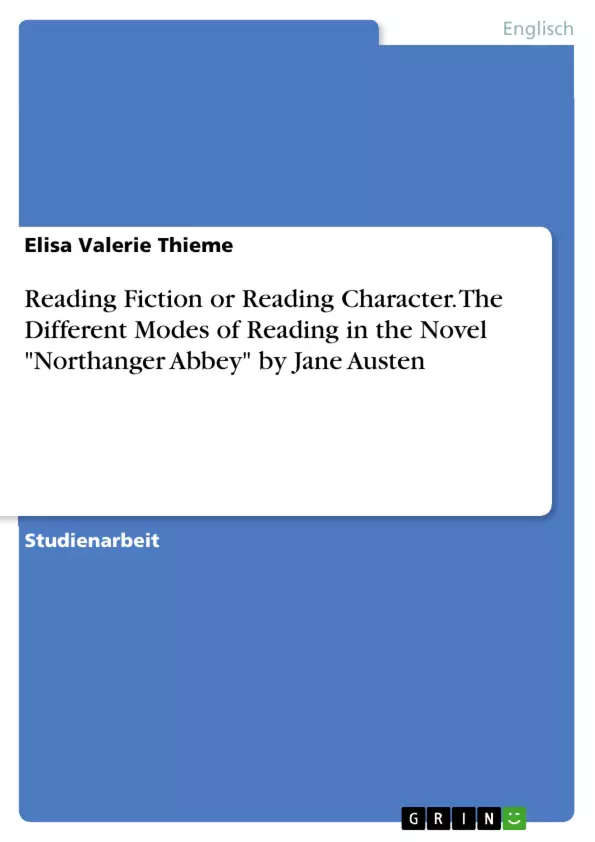Northanger Abbey was drafted in 1794, completed nine years later and finally published posthumously in 1818. It was “[w]ritten in response to contemporary fiction” and Austen herself defended her “outdated” dealings with Gothic fiction in an advertisement she had composed earlier, stating that “since it [the novel] was finished (...) period, places, manners, books, and opinions have undergone considerable changes”. Since there is a plethora of essays, papers, and novels concerned with the questions of intertextuality (Austen’s “response”) within Northanger Abbey and the question of genre (parody, pastiche, didactic novel, romance,…) has been dealt with already, this paper will concentrate on the different modes of reading discussed in the novel instead.
A focus of Northanger Abbey is the depiction of how the choice of literature shapes a character’s perception of reality and other persons. It seems logical that in “a novel about literature, the reader might expect that the literary works featured have more than an incidental importance [and in] this self-consciously literary book many of the major characters are readers”.
Therefore, in addition to a close analysis of the protagonist Catherine Morland’s (in-)capability to cope with fiction and people, this paper is concerned with four other characters, namely Isabella and John Thorpe as well as Henry and Eleanor Tilney and their reading techniques. The choice of characters to be analysed is based on Northanger Abbey’s dichotomising structure, which provides “a playground for polarities”. These polarities include the two main settings (Bath and Northanger Abbey), the novel’s parody elements (which are a binary phenomenon as well), and, of course, the character constellations.
Catherine Morland is torn between the Thorpe-siblings, on the one side, and Henry and Eleanor Tilney, who are also brother and sister, on the other side. In accordance with the strict binary plot structure, the “two men in Catherine’s life (...) are clearly contrasted, as are her two female friends”. The opposites include conduct as well as literary tastes. Since the ability to read others opens the opportunity to manipulation, there will be a chapter on this topic as well.
Inhaltsverzeichnis
- Introduction
- A Very Brief Note on Female Reading in the Early Nineteenth Century
- The Different Modes of Reading
- Catherine Morland
- Isabella Thorpe and Eleanor Tilney
- John Thorpe and Henry Tilney
- False Friends, Manipulation and the Limits of Reading Others
Zielsetzung und Themenschwerpunkte
Der Essay untersucht die verschiedenen Arten des Lesens, die in Jane Austens Roman "Northanger Abbey" dargestellt werden, und ihre Auswirkungen auf die Wahrnehmung der Realität und anderer Personen durch die Figuren. Insbesondere wird die Fähigkeit der Figuren, Fiktion und Realität zu unterscheiden, sowie ihre Fähigkeit, andere Menschen zu lesen und zu verstehen, analysiert.
- Die Rolle der Literatur bei der Gestaltung der Wahrnehmung
- Die verschiedenen Lesestrategien der Figuren
- Die Grenzen des Lesens und die Gefahr der Manipulation
- Die Bedeutung der Selbstkenntnis für das Verstehen anderer
- Die Verbindung zwischen literarischer Bildung und sozialer Kompetenz
Zusammenfassung der Kapitel
Das erste Kapitel führt in das Thema des Essays ein und stellt die zentrale Rolle des Lesens in "Northanger Abbey" dar. Es beleuchtet die verschiedenen Lesestrategien der Figuren und ihre Auswirkungen auf ihre Interaktionen. Kapitel zwei bietet einen kurzen Einblick in die Debatte um weibliche Lesekultur im frühen 19. Jahrhundert. Kapitel drei analysiert die Lesestrategien der Hauptfigur Catherine Morland und ihre Schwierigkeiten, Fiktion von Realität zu unterscheiden. Die folgenden Unterkapitel konzentrieren sich auf die Lesestrategien von Isabella Thorpe und Eleanor Tilney sowie John Thorpe und Henry Tilney. Schließlich beleuchtet das Kapitel "False Friends, Manipulation and the Limits of Reading Others" die manipulative Kraft des Lesens und die Bedeutung der Selbstkenntnis.
Schlüsselwörter
Jane Austen, Northanger Abbey, Lesekultur, weibliche Bildung, Gothic-Roman, Intertextualität, soziale Kompetenz, Manipulation, Selbstkenntnis, Catherine Morland, Isabella Thorpe, Eleanor Tilney, John Thorpe, Henry Tilney.
- Arbeit zitieren
- B.A. Elisa Valerie Thieme (Autor:in), 2014, Reading Fiction or Reading Character. The Different Modes of Reading in the Novel "Northanger Abbey" by Jane Austen, München, GRIN Verlag, https://www.grin.com/document/283218



